Spring Cloud config之二:Spring cloud config Server源码分析,springboot健康检查请求路径分析
本文主要从一些spring-cloud-config-server 包中的注解和类来分析配置中心是如何对外提供配置。
从@EnableConfigServer开始
为了让一个spring boot应用成为配置中心,我们需要使用@EnableConfigServer注解
@Target(ElementType.TYPE) @Retention(RetentionPolicy.RUNTIME) @Documented @Import(ConfigServerConfiguration.class) public @interface EnableConfigServer { }
可以看出,它引入了ConfigServerConfiguration
@Configuration public class ConfigServerConfiguration { class Marker {} @Bean public Marker enableConfigServerMarker() { return new Marker(); } }
ConfigServerConfiguration 装配了一个MarkerBean。这个bean则有开启了ConfigServerAutoConfiguration(看下面的代码中的@ConditionalOnBean参数)
@Configuration @ConditionalOnBean(ConfigServerConfiguration.Marker.class) @EnableConfigurationProperties(ConfigServerProperties.class) @Import({ EnvironmentRepositoryConfiguration.class, CompositeConfiguration.class, ResourceRepositoryConfiguration.class, ConfigServerEncryptionConfiguration.class, ConfigServerMvcConfiguration.class, TransportConfiguration.class }) public class ConfigServerAutoConfiguration { }
这里又引入了多个配置类,包括:
EnvironmentRepositoryConfiguration
CompositeConfiguration
ResourceRepositoryConfiguration
ConfigServerEncryptionConfiguration
ConfigServerMvcConfiguration
TransportConfiguration
接下来介绍EnvironmentRepositoryConfiguration
EnvironmentRepositoryConfiguration
EnvironmentRepositoryConfiguration是配置中心的关键Configuration类。这个配置类中包含很多实现了EnvironmentRepository接口的类,每个实现类都对应一种类型(git/svn/navtie/vault)的配置。 EnvironmentRepositoryConfiguration通过profile注解(对当前应用的环境)决定使用装配哪个EnvironmentRepository Bean。默认是MultipleJGitEnvironmentRepository
@Configuration @Import({ JdbcRepositoryConfiguration.class, VaultRepositoryConfiguration.class, SvnRepositoryConfiguration.class, NativeRepositoryConfiguration.class, GitRepositoryConfiguration.class, DefaultRepositoryConfiguration.class }) public class EnvironmentRepositoryConfiguration { @Bean @ConditionalOnProperty(value = "spring.cloud.config.server.health.enabled", matchIfMissing = true) public ConfigServerHealthIndicator configServerHealthIndicator( EnvironmentRepository repository) { return new ConfigServerHealthIndicator(repository); } @Configuration @ConditionalOnProperty(value = "spring.cloud.config.server.consul.watch.enabled") protected static class ConsulEnvironmentWatchConfiguration { @Bean public EnvironmentWatch environmentWatch() { return new ConsulEnvironmentWatch(); } } @Configuration @ConditionalOnMissingBean(EnvironmentWatch.class) protected static class DefaultEnvironmentWatch { @Bean public EnvironmentWatch environmentWatch() { return new EnvironmentWatch.Default(); } } } @Configuration @ConditionalOnMissingBean(EnvironmentRepository.class) class DefaultRepositoryConfiguration { @Autowired private ConfigurableEnvironment environment; @Autowired private ConfigServerProperties server; @Autowired(required = false) private TransportConfigCallback transportConfigCallback; @Bean public MultipleJGitEnvironmentRepository defaultEnvironmentRepository() { MultipleJGitEnvironmentRepository repository = new MultipleJGitEnvironmentRepository( this.environment); repository.setTransportConfigCallback(this.transportConfigCallback); if (this.server.getDefaultLabel() != null) { repository.setDefaultLabel(this.server.getDefaultLabel()); } return repository; } } @Configuration @ConditionalOnMissingBean(EnvironmentRepository.class) @Profile("native") class NativeRepositoryConfiguration { @Autowired private ConfigurableEnvironment environment; @Autowired private ConfigServerProperties configServerProperties; @Bean public NativeEnvironmentRepository nativeEnvironmentRepository() { NativeEnvironmentRepository repository = new NativeEnvironmentRepository( this.environment); repository.setDefaultLabel(configServerProperties.getDefaultLabel()); return repository; } } @Configuration @Profile("git") class GitRepositoryConfiguration extends DefaultRepositoryConfiguration { } @Configuration @Profile("subversion") class SvnRepositoryConfiguration { @Autowired private ConfigurableEnvironment environment; @Autowired private ConfigServerProperties server; @Bean public SvnKitEnvironmentRepository svnKitEnvironmentRepository() { SvnKitEnvironmentRepository repository = new SvnKitEnvironmentRepository( this.environment); if (this.server.getDefaultLabel() != null) { repository.setDefaultLabel(this.server.getDefaultLabel()); } return repository; } } @Configuration @Profile("vault") class VaultRepositoryConfiguration { @Bean public VaultEnvironmentRepository vaultEnvironmentRepository( HttpServletRequest request, EnvironmentWatch watch) { return new VaultEnvironmentRepository(request, watch, new RestTemplate()); } } @Configuration @Profile("jdbc") class JdbcRepositoryConfiguration { @Bean public JdbcEnvironmentRepository jdbcEnvironmentRepository(JdbcTemplate jdbc) { return new JdbcEnvironmentRepository(jdbc); } }
EnvironmentRepository
EnvironmentRepository是一个配置管理仓库接口,抽象了获取配置的方法:
Environment findOne(String application, String profile, String label);
它的实现类有很多,如下图所示:
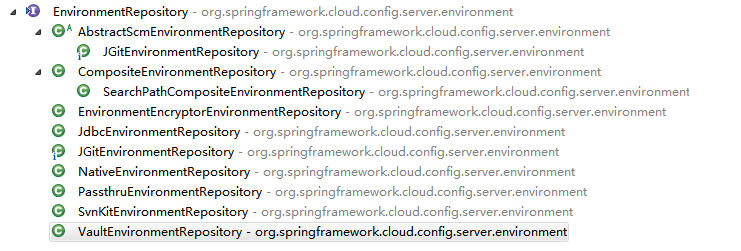
从名字中大概可以看出,这些类应该是用于加载不同类型的配置(后面会再介绍)。
上面说的主要是configserver服务端如何自动配置和加载配置文件的,下面说说这些配置如何暴露在微服务系统中。对外提供接口的类,就是EnvironmentController
交互入口1:EnvironmentController

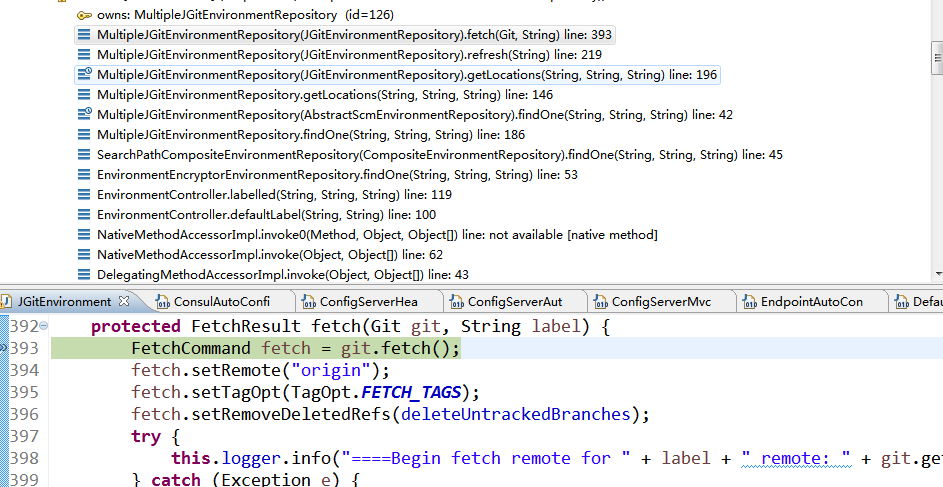
EnvironmentController是spring-cloud-config-server包的一个controller,其他服务一般是通过这个controller获取相应配置。
@RestController @RequestMapping(method = RequestMethod.GET, path = "${spring.cloud.config.server.prefix:}") public class EnvironmentController { private EnvironmentRepository repository; private ObjectMapper objectMapper; public EnvironmentController(EnvironmentRepository repository, ObjectMapper objectMapper) { this.repository = repository; this.objectMapper = objectMapper; } // 获取配置的接口 ... }
它的关键成员变量有两个:
一般情况Spring为EnvironmentController注入的类是EnvironmentEncryptorEnvironmentRepository。ObjectMapper用于当请求json格式的配置时的序列化。
EnvironmentController提供了多种获取配置的方法,这些方法主要接受application profile label这三个(或者更少)的参数,这三个参数的具体含义可以参考官网的说明,下面列举了部分方法:
@RequestMapping("/{name}/{profiles:.*[^-].*}")
public Environment defaultLabel(@PathVariable String name,
@PathVariable String profiles) {
return labelled(name, profiles, null);
}
@RequestMapping("/{name}/{profiles}/{label:.*}")
public Environment labelled(@PathVariable String name, @PathVariable String profiles,
@PathVariable String label) {
if (label != null && label.contains("(_)")) {
// "(_)" is uncommon in a git branch name, but "/" cannot be matched
// by Spring MVC
label = label.replace("(_)", "/");
}
Environment environment = this.repository.findOne(name, profiles, label);
return environment;
}
我们访问http://localhost:8081/config/mysql/dev(这是作者的配置,每个人可能不一样), 进入defaultLabel方法,它会再调用labelled方法(由于没有制定label参数,所以label传了个null)。
@RequestMapping("/{name}/{profiles}/{label:.*}")
public Environment labelled(@PathVariable String name, @PathVariable String profiles,
@PathVariable String label) {
if (name != null && name.contains("(_)")) {
// "(_)" is uncommon in a git repo name, but "/" cannot be matched
// by Spring MVC
name = name.replace("(_)", "/");
}
if (label != null && label.contains("(_)")) {
// "(_)" is uncommon in a git branch name, but "/" cannot be matched
// by Spring MVC
label = label.replace("(_)", "/");
}
StopWatch sw = new StopWatch("labelled");
sw.start();
logger.info("EnvironmentController.labelled()开始,name={},profiles={},label={}", name, profiles, label);
Environment environment = this.repository.findOne(name, profiles, label);
sw.stop();
logger.info("EnvironmentController.labelled()结束,name={},profiles={},label={},耗时={}", name, profiles, label, sw.getTotalTimeMillis());
return environment;
}
在labelled方法中,会调用repository的findOne()来加载配置,然后返回给配置获取方。
各式各样的配置仓库类
EnvironmentEncryptorEnvironmentRepository
前面提到spring config 通过EnvironmentEncryptorEnvironmentRepository加载配置
public class EnvironmentEncryptorEnvironmentRepository implements EnvironmentRepository { private EnvironmentRepository delegate; private EnvironmentEncryptor environmentEncryptor; public EnvironmentEncryptorEnvironmentRepository(EnvironmentRepository delegate, EnvironmentEncryptor environmentEncryptor) { this.delegate = delegate; this.environmentEncryptor = environmentEncryptor; } @Override public Environment findOne(String name, String profiles, String label) { Environment environment = this.delegate.findOne(name, profiles, label); if (this.environmentEncryptor != null) { environment = this.environmentEncryptor.decrypt(environment); } if (!this.overrides.isEmpty()) { environment.addFirst(new PropertySource("overrides", this.overrides)); } return environment; } }
它有一个解密器environmentEncryptor用于对加密存放的配置进行解密,另外包含一个EnvironmentRepository的实现类delegate,这里注入的类是SearchPathCompositeEnvironmentRepository
SearchPathCompositeEnvironmentRepository
SearchPathCompositeEnvironmentRepository本身并没有findOne()方法,由它的父类CompositeEnvironmentRepository实现。
public class SearchPathCompositeEnvironmentRepository extends CompositeEnvironmentRepository implements SearchPathLocator { public SearchPathCompositeEnvironmentRepository(List<EnvironmentRepository> environmentRepositories) { super(environmentRepositories); } }
CompositeEnvironmentRepository
CompositeEnvironmentRepository有一个EnvironmentRepository的列表。从它的findOne()方法可以看出:当有多个配置存放方式时,CompositeEnvironmentRepository会遍历所有EnvironmentRepository来获取所有配置。
public class CompositeEnvironmentRepository implements EnvironmentRepository { protected List<EnvironmentRepository> environmentRepositories; public CompositeEnvironmentRepository(List<EnvironmentRepository> environmentRepositories) { //Sort the environment repositories by the priority Collections.sort(environmentRepositories, OrderComparator.INSTANCE); this.environmentRepositories = environmentRepositories; } @Override public Environment findOne(String application, String profile, String label) { Environment env = new Environment(application, new String[]{profile}, label, null, null); if(environmentRepositories.size() == 1) { Environment envRepo = environmentRepositories.get(0).findOne(application, profile, label); env.addAll(envRepo.getPropertySources()); env.setVersion(envRepo.getVersion()); env.setState(envRepo.getState()); } else {
//遍历 for (EnvironmentRepository repo : environmentRepositories) { env.addAll(repo.findOne(application, profile, label).getPropertySources()); } } return env; } }
小结一下:虽然实现了EnvironmentRepository接口。但EnvironmentEncryptorEnvironmentRepository只是一个代理, SearchPathCompositeEnvironmentRepository/CompositeEnvironmentRepository也没有具体加载配置的逻辑。
而真正加载配置的类存放在CompositeEnvironmentRepository的environmentRepositories列表。
包括:NativeEnvironmentRepository: 获取本地配置;SvnRepositoryConfiguration: 获取存放在svn中的配置;VaultEnvironmentRepository: 获取存放在vault中的配置;GitRepositoryConfiguration:获取存放在git中的配置;
接下来介绍NativeEnvironmentRepository。
NativeEnvironmentRepository
NativeEnvironmentRepository 用于加载本地(native)配置。它加载配置时,其实是以特定环境(传入的profile)启动了另外一个微型spring boot应用,通过这个应用获取所有的配置,然后调用clean过滤,得到所需配置。
@ConfigurationProperties("spring.cloud.config.server.native")
public class NativeEnvironmentRepository
implements EnvironmentRepository, SearchPathLocator, Ordered {
@Override
public Environment findOne(String config, String profile, String label) {
SpringApplicationBuilder builder = new SpringApplicationBuilder(
PropertyPlaceholderAutoConfiguration.class);
ConfigurableEnvironment environment = getEnvironment(profile);
builder.environment(environment);
builder.web(false).bannerMode(Mode.OFF);
if (!logger.isDebugEnabled()) {
// Make the mini-application startup less verbose
builder.logStartupInfo(false);
}
String[] args = getArgs(config, profile, label);
// Explicitly set the listeners (to exclude logging listener which would change
// log levels in the caller)
builder.application()
.setListeners(Arrays.asList(new ConfigFileApplicationListener()));
ConfigurableApplicationContext context = builder.run(args);
environment.getPropertySources().remove("profiles");
try {
return clean(new PassthruEnvironmentRepository(environment).findOne(config,
profile, label));
}
finally {
context.close();
}
}
private ConfigurableEnvironment getEnvironment(String profile) {
ConfigurableEnvironment environment = new StandardEnvironment();
environment.getPropertySources()
.addFirst(new MapPropertySource("profiles",
Collections.<String, Object>singletonMap("spring.profiles.active",
profile)));
return environment;
}
protected Environment clean(Environment value) {
Environment result = new Environment(value.getName(), value.getProfiles(),
value.getLabel(), this.version, value.getState());
for (PropertySource source : value.getPropertySources()) {
String name = source.getName();
if (this.environment.getPropertySources().contains(name)) {
continue;
}
name = name.replace("applicationConfig: [", "");
name = name.replace("]", "");
if (this.searchLocations != null) {
boolean matches = false;
String normal = name;
if (normal.startsWith("file:")) {
normal = StringUtils
.cleanPath(new File(normal.substring("file:".length()))
.getAbsolutePath());
}
String profile = result.getProfiles() == null ? null
: StringUtils.arrayToCommaDelimitedString(result.getProfiles());
for (String pattern : getLocations(result.getName(), profile,
result.getLabel()).getLocations()) {
if (!pattern.contains(":")) {
pattern = "file:" + pattern;
}
if (pattern.startsWith("file:")) {
pattern = StringUtils
.cleanPath(new File(pattern.substring("file:".length()))
.getAbsolutePath())
+ "/";
}
if (logger.isTraceEnabled()) {
logger.trace("Testing pattern: " + pattern
+ " with property source: " + name);
}
if (normal.startsWith(pattern)
&& !normal.substring(pattern.length()).contains("/")) {
matches = true;
break;
}
}
if (!matches) {
// Don't include this one: it wasn't matched by our search locations
if (logger.isDebugEnabled()) {
logger.debug("Not adding property source: " + name);
}
continue;
}
}
logger.info("Adding property source: " + name);
result.add(new PropertySource(name, source.getSource()));
}
return result;
}
}
交互入口2:ConfigServerHealthIndicator,健康检查

ConfigServerHealthIndicator怎么加入到HealthEndpoint的,及怎么被调用的:
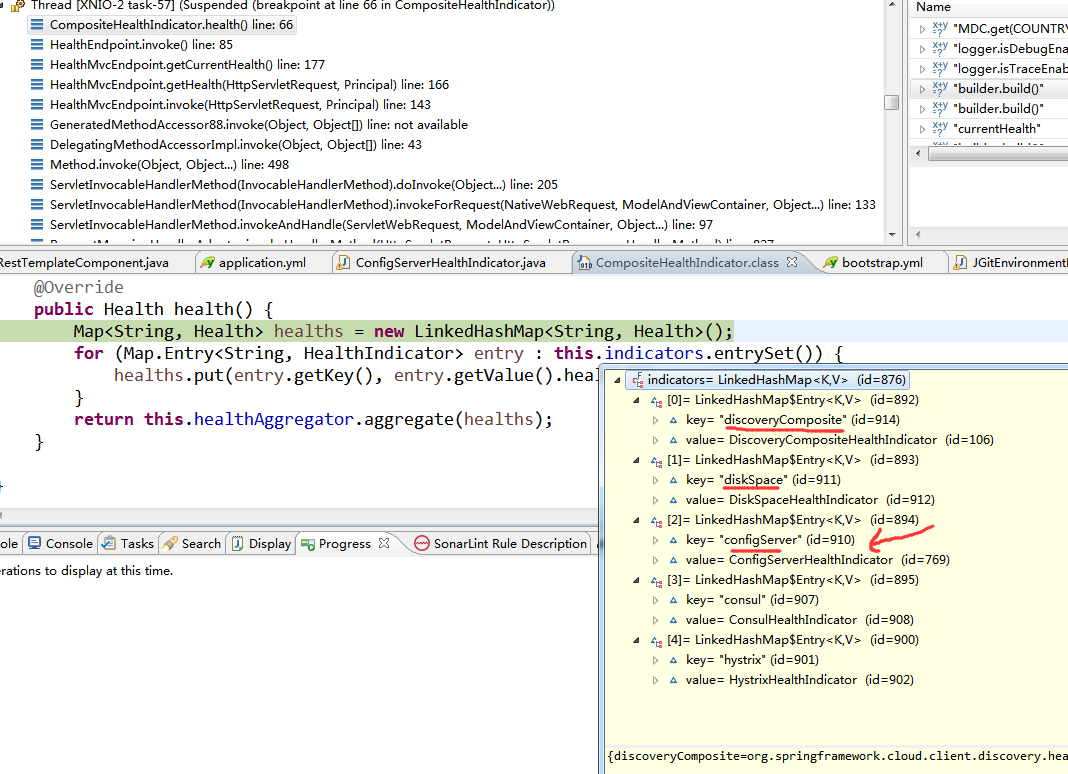
上面的调用是遍历indicators,每个indicator代表一种健康检查的HealthIndicator的实现类。
这些indicator是怎么加入的呢?
根据HealthIndicator接口类调用BeanFactoryUtils.beanNamesForTypeIncludingAncestors(this, requiredType, true, descriptor.isEager());找到所有实现类。然后把它放到上面的indicators里。
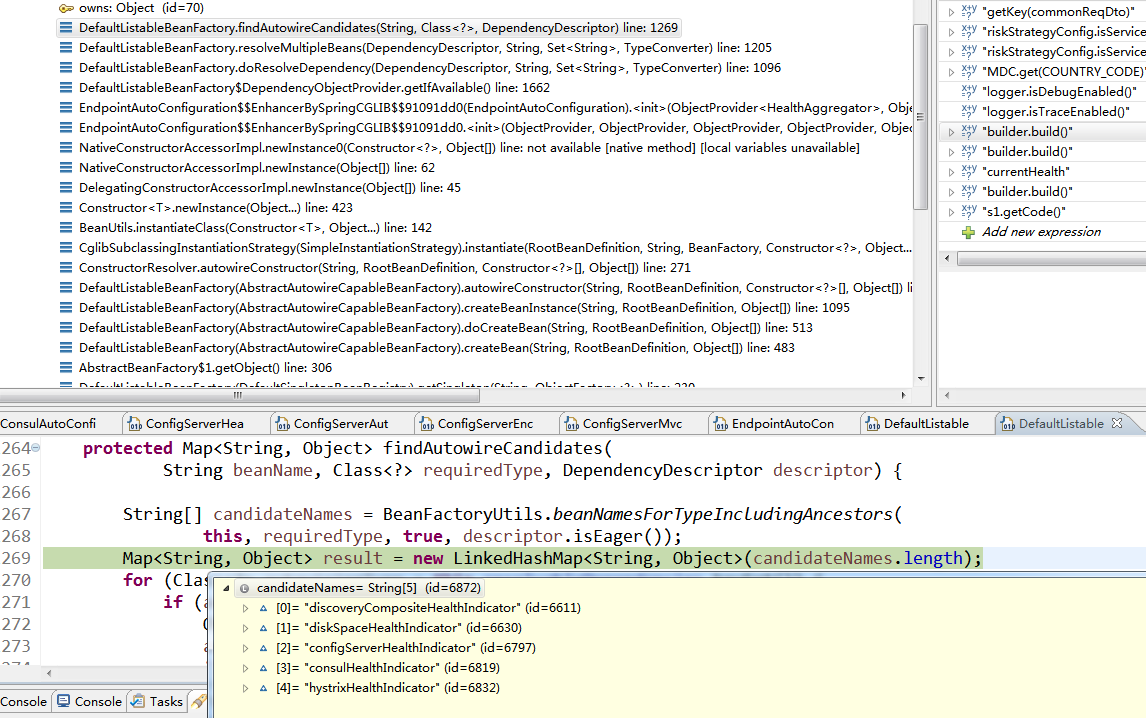
在EndpointAutoConfiguration的构造函数中,发起上述的调用。
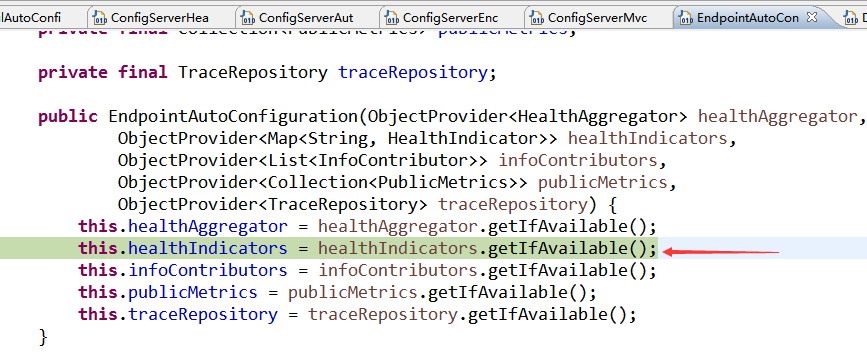
在具体看ConfigServerHealthIndicator
config-server和config-server client都有这个类,用于对资源配置中心的EnvironmentRepository是否正常工作的检测。

config-server服务端
config-server服务端的健康检查的自动配置的代码如下,同时可见spring.cloud.config.server.health.enabled的配置项是一个开关。
@Configuration @Import({ JdbcRepositoryConfiguration.class, VaultRepositoryConfiguration.class, SvnRepositoryConfiguration.class, NativeRepositoryConfiguration.class, GitRepositoryConfiguration.class, DefaultRepositoryConfiguration.class }) public class EnvironmentRepositoryConfiguration { @Bean @ConditionalOnProperty(value = "spring.cloud.config.server.health.enabled", matchIfMissing = true) public ConfigServerHealthIndicator configServerHealthIndicator( EnvironmentRepository repository) { return new ConfigServerHealthIndicator(repository); }
config-server端的ConfigServerHealthIndicator的源码:
@ConfigurationProperties("spring.cloud.config.server.health")
public class ConfigServerHealthIndicator extends AbstractHealthIndicator {
private EnvironmentRepository environmentRepository;
private Map<String, Repository> repositories = new LinkedHashMap<>();
public ConfigServerHealthIndicator(EnvironmentRepository environmentRepository) {
this.environmentRepository = environmentRepository;
}
@PostConstruct
public void init() {
if (this.repositories.isEmpty()) {
this.repositories.put("app", new Repository());
}
}
@Override
protected void doHealthCheck(Health.Builder builder) throws Exception {
builder.up();
List<Map<String, Object>> details = new ArrayList<>();
for (String name : this.repositories.keySet()) {
Repository repository = this.repositories.get(name);
String application = (repository.getName() == null)? name : repository.getName();
String profiles = repository.getProfiles();
try {
Environment environment = this.environmentRepository.findOne(application, profiles, repository.getLabel());
HashMap<String, Object> detail = new HashMap<>();
detail.put("name", environment.getName());
detail.put("label", environment.getLabel());
if (environment.getProfiles() != null && environment.getProfiles().length > 0) {
detail.put("profiles", Arrays.asList(environment.getProfiles()));
}
if (!CollectionUtils.isEmpty(environment.getPropertySources())) {
List<String> sources = new ArrayList<>();
for (PropertySource source : environment.getPropertySources()) {
sources.add(source.getName());
}
detail.put("sources", sources);
}
details.add(detail);
} catch (Exception e) {
HashMap<String, String> map = new HashMap<>();
map.put("application", application);
map.put("profiles", profiles);
builder.withDetail("repository", map);
builder.down(e);
return;
}
}
builder.withDetail("repositories", details);
}
config-server client端
config-server client端的健康检查的自动配置的代码如下,同时可见health.config.enabled是是否对config-server的健康检查的开关(config-server端的资源配置中心的EnvironmentRepository是否正常工作的检测)
@Configuration public class ConfigClientAutoConfiguration { @Configuration @ConditionalOnClass(HealthIndicator.class) @ConditionalOnBean(ConfigServicePropertySourceLocator.class) @ConditionalOnProperty(value = "health.config.enabled", matchIfMissing = true) protected static class ConfigServerHealthIndicatorConfiguration { @Bean public ConfigServerHealthIndicator configServerHealthIndicator( ConfigServicePropertySourceLocator locator, ConfigClientHealthProperties properties, Environment environment) { return new ConfigServerHealthIndicator(locator, environment, properties); } }
健康检查的核心代码:
public class ConfigServerHealthIndicator extends AbstractHealthIndicator { public ConfigServerHealthIndicator(ConfigServicePropertySourceLocator locator, Environment environment, ConfigClientHealthProperties properties) { this.environment = environment; this.locator = locator; this.properties = properties; } @Override protected void doHealthCheck(Builder builder) throws Exception { PropertySource<?> propertySource = getPropertySource(); builder.up(); if (propertySource instanceof CompositePropertySource) { List<String> sources = new ArrayList<>(); for (PropertySource<?> ps : ((CompositePropertySource) propertySource).getPropertySources()) { sources.add(ps.getName()); } builder.withDetail("propertySources", sources); } else if (propertySource!=null) { builder.withDetail("propertySources", propertySource.toString()); } else { builder.unknown().withDetail("error", "no property sources located"); } }



